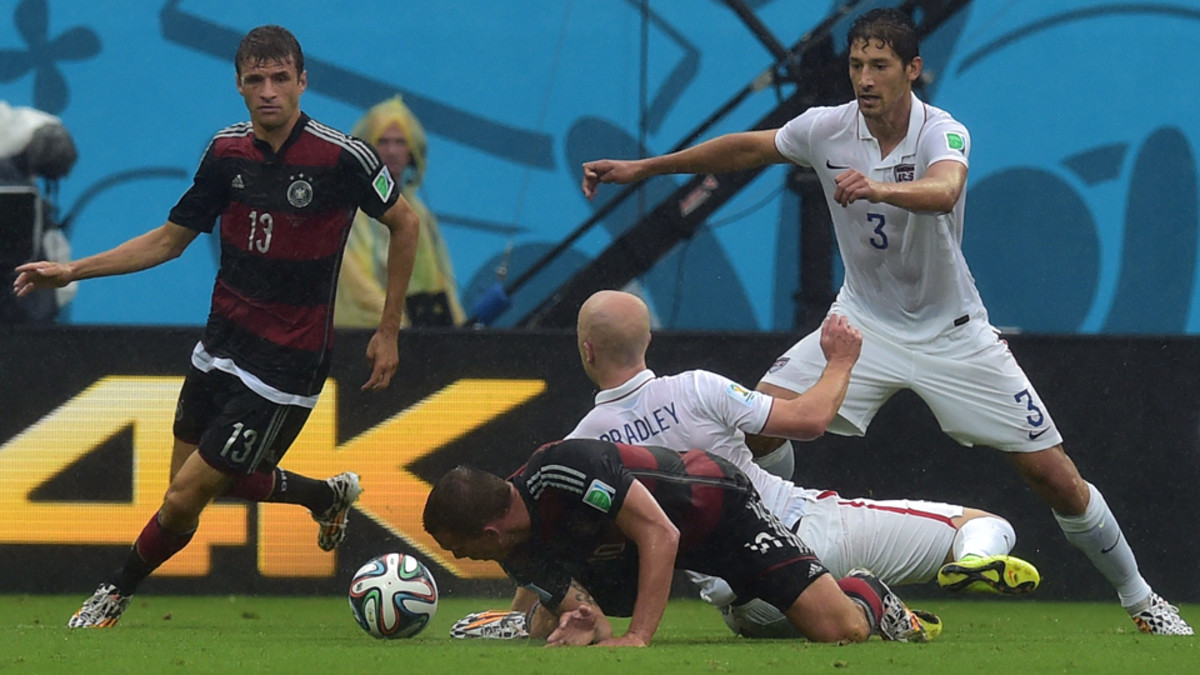
USA tactics unlikely to change against formidable World Cup knockout foes
The United States’ 1-0 loss to Germany may have felt like a win, but the next time the U.S. loses, it will be out of the World Cup. A performance like Thursday's was an acceptable result given past group achievements and the concurrent Portugal-Ghana outcome, but that minimalistic mentality probably won’t work as well against Belgium on Tuesday.
Manager Jurgen Klinsmann was comfortable enough that his team wouldn’t get hammered by Germany to rest Geoff Cameron and Alejandro Bedoya, who started the first two matches. Even if they're back in the starting 11 in Salvador, Brazil, don’t expect to see a different playing style from the one the U.S. deployed against Germany.
The U.S. is likely to be outclassed in terms of individual and collective skill from now on, barring a meeting with CONCACAF foes Mexico and Costa Rica down the line, so the Americans will likely play a tight, defensive shape and try to catch a goal on the counterattack. That sort of system yielded mixed results this month, with a comfortable win over Nigeria in the last warm-up friendly, a narrow win over Ghana and a loss to Germany.
Germany pressured from the beginning of the game on Thursday, and the U.S. attempted just 15 passes in the first 10 minutes. Soggy conditions in Recife didn’t help, and Matt Besler said after the game that the teams weren’t allowed to warm up on the pitch, so the Americans took a while to settle into the match.
Unlike against Portugal, the U.S. didn’t concede early, but the Germans still dominated the opening stages. Slowly, the U.S. adventured forward with the ball more often, and until it conceded the only goal of the game, possession was closer to even. Germany dominated the ball again from when it scored until the match ended, as the U.S. tried to avoid conceding what could have been a fatal second goal.
The U.S.’s ball circulation was too slow, and numbers in attack too few, to cause frequent problems for a relaxed German back line. Similar to the matches against Ghana and Portugal, the emphasis on a compact defensive shape made it difficult to break forward with numbers.
When Germany took possession in its own end, the U.S. maintained a 4-1-4-1 shape, with Kyle Beckerman recovering in front of the center backs as soon as the U.S. lost the ball. The U.S. held a line of confrontation around midfield, comfortable stalking Germany as it kept the ball in the back.
As the ball advanced, the shape collapsed into a 4-3-2-1. Wingers Graham Zusi and Alejandro Bedoya, who flipped sides sporadically during the run of play, dropped on either side of Beckerman and at times in line with the back four. Michael Bradley and Jermaine Jones held in front of them and took turns advancing from that position when in possession.
Germany attacked through the wings, primarily on the right. Mesut Özil tucked in to play alongside Thomas Müller and give Jérôme Boateng space to advance down the flank. Zusi and Davis followed the wide players, which gave the U.S.’s 4-3-2-1 a bit of untraditional flare at the bottom of the midfield block.
Typically, fullbacks track opposing wingers, and wide midfielders mark the advancing fullbacks, but the U.S. wanted some extra insurance when defending wide. The wingers slid to prevent isolation against their fullback partners as the ball moved out of the middle. 2-on-2 match-ups are more favorable for the defensive side than 2-on-1 or even 1-on-1, because the margin for error is larger when working in tandem defensively.
This is a similar system to the one the U.S. deployed against Nigeria, but Germany is a much better team and caused more problems with the off-ball movement among its top six players. Despite a crowded central area, the central midfield triangle of Philipp Lahm, Toni Kroos and Bastian Schweinsteiger completed a combined 92 percent of its passes, with Lahm leading the way at 95 percent.
Despite the heavy concentration of numbers, the U.S. still looked vulnerable in the back. Omar Gonzalez made several last-second tackles and recoveries to break up German attacks, but he was not the only defender caught out of position.
In this example, Gonzalez pulled wide to assist Fabian Johnson in defending a cross. The service was cleared but landed at Schweinsteiger’s feet outside the penalty area, and he hit a long shot. DaMarcus Beasley blocked it, but the ball rolled to Boateng on the edge of the penalty area.
The defenders had time to recover their shape as the play developed. Instead, as Boateng lifted a cross behind the back line and toward Podolski, they were still out of position. The gap between center backs Besler and Gonzalez was large enough that Beckerman and Bradley both sprinted to cover it.
Either Besler needed to step up quickly with the other defenders to catch all three attackers offside in the penalty area, or all defenders needed to stay goal-side of their marks. As it happened, Besler singlehandedly kept them onside. If Boateng put more pace on his cross, Podolski would have easily nodded it in.
Instead, Gonzalez recovered to fight off the service for a corner kick. The play looked spectacular, but it was the type of recovery play that’s hard to count on making every time, and it was far from ideal defending.
Klinsmann has done well to mask the U.S.’s deficiencies, bringing a group of physically and psychologically well-prepared players into a tactical scheme that fits them, but the second round of the World Cup is when technique and IQ win games and tired legs and minds begin to falter.
The U.S. was already running on fumes against Germany, surviving after a long trip to the Amazon. It’s likely this team will begin to bear the mileage and exertion of the World Cup more than any further opponents it faces.









